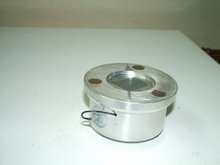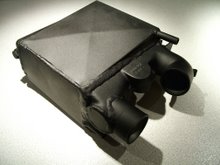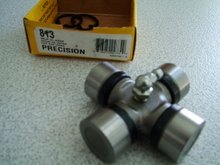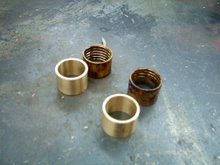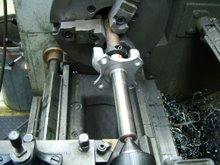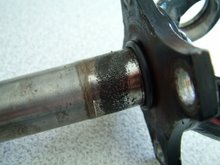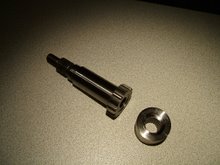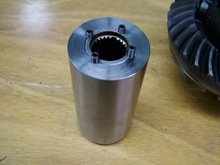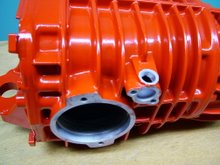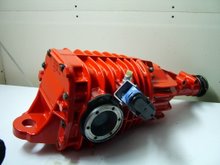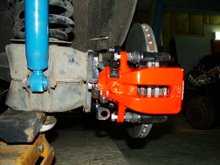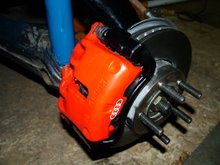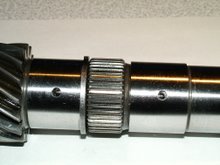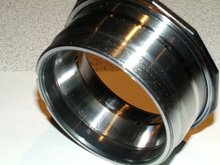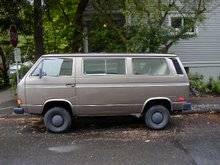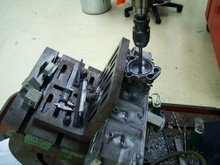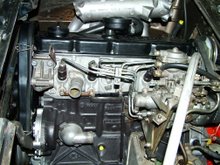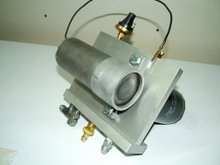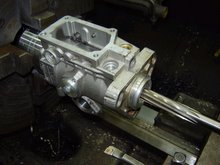Since I have an liquid to air intercooler and the engine and transmission oil coolers are watercooled also, I needed an large cooler in front of the van and I thought that instead of mounting it in front of the radiator and adding more heat to the engine radiator, I could mount it in the luggage rack on top of the roof.
I never carry anything up there anyway and it is out of the way, so I cut two luggage racks up so that I could extend it about six inches and create a air scoop. (just like the early vans have)
I ran two 3/4" lines from the intercooler and oil coolers up though the tray and out through the roof to a VW Jetta radiator, an electric waterpump circulates the cooling fluid and pumps when the diesel engine runs.
A screen keeps the crows out and the over hang also keeps the sun out of my eyes.
Tuesday, March 16, 2010
Bigger brake booster
To improve my brakes, I have installed Audi G60 brake calipers and vented rotors on the front and vented disc brakes on the back but I thought that I could improve the brake system even more by installing a bigger brake booster.
After scrounging through a lot of wrecking yards and looking at brake boosters I found a 10" booster that will fit the Vanagon without any major modifications.
The original Vanagon brake booster has a 9" diameter so an upgrade to a 10" means that it is like putting about 20 percent more force on the pedal with the same effort.
The brake booster came from a E30 (3) series BMW, which is easy to find in wrecking yards, made from 1982---- 1990, and until 1993 for the convertible.
To make it fit, a 1/4" piece has to be cut off the threaded rod, then the original clevis from a Vanagon has to be drilled out and tapped to M10x1.5 (drill with a 11/32" drill) and mounted onto the threaded rod.
Adjust the length of the rod to 111,5 MM or 4 3/8" from booster mounting face to the center of the clevis. (see Bentley page 46.10)
I took the instrument panel out, removed the master brake cylinder, unbolted the aluminum pedal frame and took the booster out.
While I was in there I also took the clutch pedal out and checked and lubricated the pin.
In order to get the clutch pedal out, the main pin has to be partially slid out, just enough to get the clutch pedal out.
Check and see if the hole in the pedal is not wore out and that the pin is in good shape.
Here is a link that describes it:
http://www.thesamba.com/vw/forum/viewtopic.php?t=401822&highlight=bigger+brake+booster
After scrounging through a lot of wrecking yards and looking at brake boosters I found a 10" booster that will fit the Vanagon without any major modifications.
The original Vanagon brake booster has a 9" diameter so an upgrade to a 10" means that it is like putting about 20 percent more force on the pedal with the same effort.
The brake booster came from a E30 (3) series BMW, which is easy to find in wrecking yards, made from 1982---- 1990, and until 1993 for the convertible.
To make it fit, a 1/4" piece has to be cut off the threaded rod, then the original clevis from a Vanagon has to be drilled out and tapped to M10x1.5 (drill with a 11/32" drill) and mounted onto the threaded rod.
Adjust the length of the rod to 111,5 MM or 4 3/8" from booster mounting face to the center of the clevis. (see Bentley page 46.10)
I took the instrument panel out, removed the master brake cylinder, unbolted the aluminum pedal frame and took the booster out.
While I was in there I also took the clutch pedal out and checked and lubricated the pin.
In order to get the clutch pedal out, the main pin has to be partially slid out, just enough to get the clutch pedal out.
Check and see if the hole in the pedal is not wore out and that the pin is in good shape.
Here is a link that describes it:
http://www.thesamba.com/vw/forum/viewtopic.php?t=401822&highlight=bigger+brake+booster
Tuesday, December 15, 2009
GPS in instrument cover
I made a place to store the Garmin GPS inside the instrument cover, it is a pain every time I park the van to take the GPS off the windshield and hide it somewhere so that it doesn't get stolen.
It was easy to make, I cut out an opening on the top of the right hand side of the instrument cover, then I made a frame from a piece of aluminium strip and glued and pop riveted it onto a piano hinge. Next was to cut out a lid of a spare cover so that it fits nicely in the opening and glued it on top of the alu frame. If you have no spare cover to cut it out off you will end up with slightly wider seams, which is OK.
Then I glued and pop riveted the hinge to the instrument cover and glued a small strip of material in so that the lid rests on it when it is closed. I then made a push button that will pop the lid up a 1/2 " so that I can grab it and open it up all the way.
To keep it open, I pop riveted a small arm on the bottom of the alu frame and put some industrial Velcro on it.
There is a small opening on the bottom to route the power wire through, I also drilled 6 small holes in the lid to let the sound out.
The glue that I have used is for repairing plastic bumpers, it sticks really well, the push button is made out of a Hilti concrete screw, it has a plastic liner that guides it, in the end of the screw, I have cut a small groove with the hacksaw and wrapped a thin copper wire around it to keep it from falling out.
The GPS is held in place with some Velcro strips on the back.
Now when I park the van, I just flip it down and it is out of sight.
It was easy to make, I cut out an opening on the top of the right hand side of the instrument cover, then I made a frame from a piece of aluminium strip and glued and pop riveted it onto a piano hinge. Next was to cut out a lid of a spare cover so that it fits nicely in the opening and glued it on top of the alu frame. If you have no spare cover to cut it out off you will end up with slightly wider seams, which is OK.
Then I glued and pop riveted the hinge to the instrument cover and glued a small strip of material in so that the lid rests on it when it is closed. I then made a push button that will pop the lid up a 1/2 " so that I can grab it and open it up all the way.
To keep it open, I pop riveted a small arm on the bottom of the alu frame and put some industrial Velcro on it.
There is a small opening on the bottom to route the power wire through, I also drilled 6 small holes in the lid to let the sound out.
The glue that I have used is for repairing plastic bumpers, it sticks really well, the push button is made out of a Hilti concrete screw, it has a plastic liner that guides it, in the end of the screw, I have cut a small groove with the hacksaw and wrapped a thin copper wire around it to keep it from falling out.
The GPS is held in place with some Velcro strips on the back.
Now when I park the van, I just flip it down and it is out of sight.
Sunday, December 6, 2009
Almost done!
The van is almost together, the Westy interior is installed, exept for the fridge. The front seats, with seat heaters, are back in, new carpets in front, lino tiles in the back, radio installed, all windows have new rubber seals as well as all the doors. Rear windows are tinted, central locking, alarm installation, LED taillights and front turn signal lights. I am waiting for the new Yokohama Geolandar tires and the tire pressure monitoring system to come in that I will install at the same time. Still working on the front roof luggage rack that has the heat exchanger in it for the intercooler. Had the van outside today to let the engine warm up, watch the video.
Tuesday, September 8, 2009
New paint job
I just got the Syncro back from the body shop, I had done all the body work but I did not want to paint the van myself,I don't have a paint boot and I am sure that they do a better job than I can at home.
So now I am putting everything back in, new window seals, door rubbers, SA grille, bigger electric mirrors, front carpets, bigger fridge, new three window pop-up tent, solar panel etc.
I have converted the taillights and front turn signal lights to LED's and got some Bi Xenon HID lights for the front.
Painting the bumpers and installing the winch is next on the list.
So now I am putting everything back in, new window seals, door rubbers, SA grille, bigger electric mirrors, front carpets, bigger fridge, new three window pop-up tent, solar panel etc.
I have converted the taillights and front turn signal lights to LED's and got some Bi Xenon HID lights for the front.
Painting the bumpers and installing the winch is next on the list.
Friday, June 12, 2009
G and Reverse synchronizer
A problem that shows up in the Syncro gearbox after installing a TDI diesel is that the original bronze synchronizer rings get loose on the pins, which break and fall down in between the rotating gears.
They then end up smashing a hole in the transmission housing.
I made some stronger steel rings and brazed a bronze layer on, milled the grooves in the back side where the small springs fit in and finished the friction surface.
I then made a set of pins out of a special steel bolt and tapped internal thread in it.
The new steel synchronizer rings are then bolted to the pins with flat head Allan type bolts which have a tapered seat. I have put a small spot weld on it to prevent it from loosening itself.
I think that this problem is caused by the harsh vibrations of the TDI engine running without a dual mass flywheel, this causes the pins to loosen off in the softer bronze synchronizer rings and eventually it will break.
If you have problems shifting into Low or Reverse don't wait too long and take your transmission apart, it could self destruct within a 1000 KM.
Time will tell if this mod will work.
They then end up smashing a hole in the transmission housing.
I made some stronger steel rings and brazed a bronze layer on, milled the grooves in the back side where the small springs fit in and finished the friction surface.
I then made a set of pins out of a special steel bolt and tapped internal thread in it.
The new steel synchronizer rings are then bolted to the pins with flat head Allan type bolts which have a tapered seat. I have put a small spot weld on it to prevent it from loosening itself.
I think that this problem is caused by the harsh vibrations of the TDI engine running without a dual mass flywheel, this causes the pins to loosen off in the softer bronze synchronizer rings and eventually it will break.
If you have problems shifting into Low or Reverse don't wait too long and take your transmission apart, it could self destruct within a 1000 KM.
Time will tell if this mod will work.
Friday, April 3, 2009
Front winch bumper
Another project that I have been working on are the bumpers, I wanted to install a winch on the front bumper and for the rear bumper I needed a spare tire carrier, the 17" tire does not fit under the front where the original spare was.
I have used 2" pipe, elbows and caps for it.
There is a receiver hitch on the front bumper as well as the rear bumper, when I put the boat in the water, the muffler and lower part of the engine always ended up submerged and I was worried that it would stall, it is also a lot easier.
For the spare tire I made an arm that fits in between the two tubes and swings out of the way when I have to open the rear hatch.
Once finished, I'll paint both of them black with spay-on bed liner.
I have used 2" pipe, elbows and caps for it.
There is a receiver hitch on the front bumper as well as the rear bumper, when I put the boat in the water, the muffler and lower part of the engine always ended up submerged and I was worried that it would stall, it is also a lot easier.
For the spare tire I made an arm that fits in between the two tubes and swings out of the way when I have to open the rear hatch.
Once finished, I'll paint both of them black with spay-on bed liner.
Auxiliary Heater
I have an Eberspacher BN2 auxiliary heater that ran on gasoline that I would like to use in the diesel Syncro, it came out of portable tool kit.
It is really hard to find glow plugs for these units, mine was broken, so I looked on Ebay and found one that I thought I could convert. It is a 12 volt unit compared to the 4 volt original one but in order to make it work I had to install a relais that supplies 12 volt to it.
The relais is triggered by the wire from the original glow plug.
I took the whole heater apart and lubricated the bearings, cleaned the points and checked the combustion chamber.
On the picture it shows it running, I adjusted the fuel pump for the right mixture and ran it all day, also to see if it stopped and started correctly on diesel fuel.
Runs great, I will just use a timer on it, no thermostat.
It is really hard to find glow plugs for these units, mine was broken, so I looked on Ebay and found one that I thought I could convert. It is a 12 volt unit compared to the 4 volt original one but in order to make it work I had to install a relais that supplies 12 volt to it.
The relais is triggered by the wire from the original glow plug.
I took the whole heater apart and lubricated the bearings, cleaned the points and checked the combustion chamber.
On the picture it shows it running, I adjusted the fuel pump for the right mixture and ran it all day, also to see if it stopped and started correctly on diesel fuel.
Runs great, I will just use a timer on it, no thermostat.
Sunday, February 15, 2009
Auxiliary fuel tanks
I installed the two auxiliary fuel tanks that I had made, after looking at how to fill the tanks, I thought the easiest way would be to put a T fitting on the original tank and have a small pump transfer the fuel into the left tank first until it is full and then through an overflow fill the right side tank.
If both tanks are full, it will overflow into a T connection on the filler neck back into the original tank. The other options would have been to put an additional filler neck where the 2 wheel drive version has it and then pump it into the other tank from there on, or to install a third filler neck on the driverside.
This pump is a vane pump that pumps about 5 gallon/min, so to fill both aux tanks should take about an extra 7 minutes.
If both tanks are full, it will overflow into a T connection on the filler neck back into the original tank. The other options would have been to put an additional filler neck where the 2 wheel drive version has it and then pump it into the other tank from there on, or to install a third filler neck on the driverside.
This pump is a vane pump that pumps about 5 gallon/min, so to fill both aux tanks should take about an extra 7 minutes.
Friday, August 15, 2008
Conversion from Indirect Injection to Direct Injection
This will also work for the 1.6 TD engines.
I have been working to convert an Indirect Injection Engine(IDI) into a Direct Injection Engine (TDI) and fit it in the blue Syncro after the brown one is done.
As I had a few Audi 5 cyl 2.0 TD engines laying around I thought that it would be interesting to convert one of them into a TDI and see if it would run OK and how much improvement there would be in fuel consumption.
I bought a 2.5 TDI cylinder head on Ebay Germany with a set of injectors, injection lines and an TDI Injection pump.
I am using pistons from a Renault 1.5 Clio diesel and modified them to make them fit and compensate for the 6 mm longer stroke of the Audi.
As one of the engines had the last oversize pistons in there, I had a set of sleeves installed in the block and honed out to the 76 mm of the Renault piston.
I have modified the original Audi TD injection pump to accept the 20 mm TDI pump shaft and clearanced the timing advance piston, TDI's need lots of advance.
Also changed the pump internally so that it has four rollers on the camplate instead of the TD's original three.
I will keep you posted on the progress.
I have been working to convert an Indirect Injection Engine(IDI) into a Direct Injection Engine (TDI) and fit it in the blue Syncro after the brown one is done.
As I had a few Audi 5 cyl 2.0 TD engines laying around I thought that it would be interesting to convert one of them into a TDI and see if it would run OK and how much improvement there would be in fuel consumption.
I bought a 2.5 TDI cylinder head on Ebay Germany with a set of injectors, injection lines and an TDI Injection pump.
I am using pistons from a Renault 1.5 Clio diesel and modified them to make them fit and compensate for the 6 mm longer stroke of the Audi.
As one of the engines had the last oversize pistons in there, I had a set of sleeves installed in the block and honed out to the 76 mm of the Renault piston.
I have modified the original Audi TD injection pump to accept the 20 mm TDI pump shaft and clearanced the timing advance piston, TDI's need lots of advance.
Also changed the pump internally so that it has four rollers on the camplate instead of the TD's original three.
I will keep you posted on the progress.
Hydrogen generator
As I need to have a few projects going at the same time I have been experimenting with a hydrogen generator.
It consists out of a set of stainless steel plates that are submerged in distilled water with some potassium hydrochloride (KOH) mixed in the water to get the current flowing. Connected to a 12 volt battery it starts to generate Hydrogen gas which then flows into the engines intake.
This will improve the combustion process and save fuel( look on Youtube under HHO generation)or so the story goes.
I have made a few different models but am in the process of testing them to see if indeed it will improve the mileage.
It consists out of a set of stainless steel plates that are submerged in distilled water with some potassium hydrochloride (KOH) mixed in the water to get the current flowing. Connected to a 12 volt battery it starts to generate Hydrogen gas which then flows into the engines intake.
This will improve the combustion process and save fuel( look on Youtube under HHO generation)or so the story goes.
I have made a few different models but am in the process of testing them to see if indeed it will improve the mileage.
Friday, May 30, 2008
Front shock absorbers
Last year I made some extended front shock absorbers from some truck shocks,after installation I found out that I made them a little too long. The front suspension is too stiff and hardly moves down.
So a modification was in order and I ordered a set of Old Man Emu front shocks which I modified.
I used some pieces of pipe and welded a solid piece of bar on the bottom that is 1 3/8" long and has the diameter of the original shock.
Next I cut the bottom eyes of the brand new shocks(sometimes you have to take a bit of a risk)and pressed the rubber bushing out of it, welded the eye to the tube bottom, powder coated it (the yellow that I used was a bit off from the original color, but beggars can't be choosers)and pressed the rubber bushing back in place.
Now I have to install it and rotate the shock so that the spring coil doesn't hit the upper A-arm when the suspension is totally extended.
Once installed, I will have to make 2 small welds to weld the tube to the spring plate.(Note:If you do this, do not weld to the shock itself, it may explode!)
It should lift the van up about 2" and still have the full stroke of the shock available.
The only material used is two pieces of pipe and two 1 3/8" pieces of solid bar.
The bottom of the shock is resting on the solid bar and the tube is touching the spring plate of the shock absorber.
So a modification was in order and I ordered a set of Old Man Emu front shocks which I modified.
I used some pieces of pipe and welded a solid piece of bar on the bottom that is 1 3/8" long and has the diameter of the original shock.
Next I cut the bottom eyes of the brand new shocks(sometimes you have to take a bit of a risk)and pressed the rubber bushing out of it, welded the eye to the tube bottom, powder coated it (the yellow that I used was a bit off from the original color, but beggars can't be choosers)and pressed the rubber bushing back in place.
Now I have to install it and rotate the shock so that the spring coil doesn't hit the upper A-arm when the suspension is totally extended.
Once installed, I will have to make 2 small welds to weld the tube to the spring plate.(Note:If you do this, do not weld to the shock itself, it may explode!)
It should lift the van up about 2" and still have the full stroke of the shock available.
The only material used is two pieces of pipe and two 1 3/8" pieces of solid bar.
The bottom of the shock is resting on the solid bar and the tube is touching the spring plate of the shock absorber.
Thursday, March 13, 2008
Gauge Pod
I made a gauge pod today from some 2" PVC-90 degr elbow's, cut them in half and sprayed some underbody coating on them so that they have some texture on them and painted them black with bumper paint.
Next I made an aluminum plate and cut 5 holes in it and held it against the belt sander to give it a brushed look,then glued all elbow's onto it.
Because the gauges that I used were quite deep, I made some aluminum rings that pressed into the elbow's and gave some extra dept.
It fits right over the ashtray opening.
Next I made an aluminum plate and cut 5 holes in it and held it against the belt sander to give it a brushed look,then glued all elbow's onto it.
Because the gauges that I used were quite deep, I made some aluminum rings that pressed into the elbow's and gave some extra dept.
It fits right over the ashtray opening.
Saturday, July 14, 2007
Upper A-arm ball joint spacer
After I installed my extended front shock absorbers, the upper A-arm moved down quite a bit and the ball joint angle became too steep, the rubber boot kept popping off the joint.( I have about 23" between the hub center and the fender, unloaded)
Also it looked like I ended up with too much negative caster.
I made a spacer that bolts in between the joint and the upper arm, it moves the arm up a bit and it also tilts the ball joint.
There is a retainer plate that secures the spacer in place with one bolt through the center and two bolts through the original ball joint mounting holes.
I may have to make a different one later as I have not done a wheel alignment yet.
Also it looked like I ended up with too much negative caster.
I made a spacer that bolts in between the joint and the upper arm, it moves the arm up a bit and it also tilts the ball joint.
There is a retainer plate that secures the spacer in place with one bolt through the center and two bolts through the original ball joint mounting holes.
I may have to make a different one later as I have not done a wheel alignment yet.
Saturday, May 19, 2007
Laser Alignment Tool
On the Syncro's it is hard to align the engine and transmission with the front differential in order to minimize driveline vibrations.
The engine has to be mounted slightly offset to one side so that the driveshaft sits in the center of the frame.
To make this easier to set up, I have made an aluminum hub that holds the laser, taken out of a laser level, and has magnets on the flange side so that it just sticks to the driveshaft flange.
I can now measure the distance between the frame rails and the centerline to make sure the engine and transmission are square with the frame and at the same time aligns with the front differential center flange.
The engine has to be mounted slightly offset to one side so that the driveshaft sits in the center of the frame.
To make this easier to set up, I have made an aluminum hub that holds the laser, taken out of a laser level, and has magnets on the flange side so that it just sticks to the driveshaft flange.
I can now measure the distance between the frame rails and the centerline to make sure the engine and transmission are square with the frame and at the same time aligns with the front differential center flange.
Saturday, March 10, 2007
Intercooler
The intercooler that I use comes from a Saab, it is an all aluminum cooler that I have welded a water jacket around. I also had to cut one of the elbows off and weld a straight connector on.
It fits behind the left taillight and it keeps the hoses to the turbo and intake manifold really short.
I will be using an air conditioning evaporator mounted next to the Vanagon radiator with a cooling fan, the fluid will be pumped around by an electric water pump through the engine oil cooler, transmission oil cooler and then through the intercooler.
This way I don't have to run hoses for 3 coolers to the front.
It fits behind the left taillight and it keeps the hoses to the turbo and intake manifold really short.
I will be using an air conditioning evaporator mounted next to the Vanagon radiator with a cooling fan, the fluid will be pumped around by an electric water pump through the engine oil cooler, transmission oil cooler and then through the intercooler.
This way I don't have to run hoses for 3 coolers to the front.
Saturday, March 3, 2007
Drive shaft
The drive shaft felt OK when I bought the vehicle but with 170,000 miles on it, it would be better to take it apart and put some new U joints in it.
They actually still looked good, the grease was hard and black, there was some brinelling from the needles but it would have lasted a few more years. The rubber donut looked fine, so I just re-used it. You can still buy new ones, they are used by BMW on some of their older models.
I bought some new universal joints for it at Lordco, they are not listed under Vanagon Syncro but under PTO shafts, size is 27 mm x 70 mm. Before I paid for them, I checked with a small file if they were heat treated, a lot of u joints are soft and won't last at all. They came with a grease nipple and 2 circlip sizes so you can take the play out of them.
I had to machine the grease nipples so that they would screw in deeper, they won't fit as supplied.
An often overlooked problem with the later style Syncro drive shafts are the bronze bushings that are located under the rubber donut, they wear out and cause vibrations in the drive line.To remove them, I put a thread into them, 1'' just fits, then used a piece of ready rod with nut, washers and a piece of pipe to pull them out.
Mine had a lot of wear and corrosion and I had to machine 0.035" off the shaft to clean it up, I made two new bronze bushings and pressed them back in the drive shaft. Next I fitted it all back together, I had to use the thicker circlips in order to get all the play out of the cups.
On the Syncro, it is important that the drive shaft is well aligned, both the tranny and the front diff flanges have an angle of about 4 degrees. If you do an engine conversion, and the engine hangs too low, you could end up with some vibration. Another thing to watch out for when doing a conversion is that the original VW engine is slightly offset towards the driverside, about 17 mm, if the new engine is installed in the center of the engine compartment, it will put another angle on the drive shaft that is not compensated for by the front diff and it may cause a vibration also. It is too bad that VW didn't put a CV joint in, one would have been enough.
On a two wheel drive Vanagon it is not that critical if the engine is centered, the axle CV joints will compensate for that.
Total cost for the U joints was about $ 80.00 and it took me 5 hours to machine the parts and put it all back together.
They actually still looked good, the grease was hard and black, there was some brinelling from the needles but it would have lasted a few more years. The rubber donut looked fine, so I just re-used it. You can still buy new ones, they are used by BMW on some of their older models.
I bought some new universal joints for it at Lordco, they are not listed under Vanagon Syncro but under PTO shafts, size is 27 mm x 70 mm. Before I paid for them, I checked with a small file if they were heat treated, a lot of u joints are soft and won't last at all. They came with a grease nipple and 2 circlip sizes so you can take the play out of them.
I had to machine the grease nipples so that they would screw in deeper, they won't fit as supplied.
An often overlooked problem with the later style Syncro drive shafts are the bronze bushings that are located under the rubber donut, they wear out and cause vibrations in the drive line.To remove them, I put a thread into them, 1'' just fits, then used a piece of ready rod with nut, washers and a piece of pipe to pull them out.
Mine had a lot of wear and corrosion and I had to machine 0.035" off the shaft to clean it up, I made two new bronze bushings and pressed them back in the drive shaft. Next I fitted it all back together, I had to use the thicker circlips in order to get all the play out of the cups.
On the Syncro, it is important that the drive shaft is well aligned, both the tranny and the front diff flanges have an angle of about 4 degrees. If you do an engine conversion, and the engine hangs too low, you could end up with some vibration. Another thing to watch out for when doing a conversion is that the original VW engine is slightly offset towards the driverside, about 17 mm, if the new engine is installed in the center of the engine compartment, it will put another angle on the drive shaft that is not compensated for by the front diff and it may cause a vibration also. It is too bad that VW didn't put a CV joint in, one would have been enough.
On a two wheel drive Vanagon it is not that critical if the engine is centered, the axle CV joints will compensate for that.
Total cost for the U joints was about $ 80.00 and it took me 5 hours to machine the parts and put it all back together.
Wednesday, February 21, 2007
Decoupler
Since I had taken the VC out, I had to have a way to disconnect the front differential. The driveline will bind up quickly on dry paved roads and it becomes really hard to make a turn.
After some research on the web, I found out that there is a choice of two systems, one is like the original system used by VW and it is manufactured in South Africa, it looks like the strongest of the two. The other is made in the USA and uses the original splined sleeve that is in every Syncro, they added a bearing onto the sleeve which is moved by a shift fork.
It looked like I could make either one of them myself, the SA one would be the hardest to make,but I really liked the design.
So I gave it a try, I got a piece of 4340 bar stock, machined it and put splines on it in the milling machine. I ended up making two of them, the first one I screwed up trying to heat treat it myself. Some things are best left to an expert.
The hardest part for me to make myself was the internal spline of the gear hub, I ended up using an old fashioned shaper with an index.
The sliding collar (the part that I thought would be the hardest to make) came from a Chev S10 front differential, it just fitted in the housing. I made a shift fork out of a slice of bronze bar stock, drilled the housing for the shift rod and electrical switch and made a bracket for the vacuum actuator.
I had the shaft and gear heat treated, pressed a needle bearing into the shaft and fitted it all together.
After some research on the web, I found out that there is a choice of two systems, one is like the original system used by VW and it is manufactured in South Africa, it looks like the strongest of the two. The other is made in the USA and uses the original splined sleeve that is in every Syncro, they added a bearing onto the sleeve which is moved by a shift fork.
It looked like I could make either one of them myself, the SA one would be the hardest to make,but I really liked the design.
So I gave it a try, I got a piece of 4340 bar stock, machined it and put splines on it in the milling machine. I ended up making two of them, the first one I screwed up trying to heat treat it myself. Some things are best left to an expert.
The hardest part for me to make myself was the internal spline of the gear hub, I ended up using an old fashioned shaper with an index.
The sliding collar (the part that I thought would be the hardest to make) came from a Chev S10 front differential, it just fitted in the housing. I made a shift fork out of a slice of bronze bar stock, drilled the housing for the shift rod and electrical switch and made a bracket for the vacuum actuator.
I had the shaft and gear heat treated, pressed a needle bearing into the shaft and fitted it all together.
Sunday, February 18, 2007
Locking front differential
I started out with the original front differential that had no diff lock, but looking at it a bit closer, I could see that the casting was prepared for a diff lock, all that had to be done was to bore out the housing on a milling machine, drill and tap the hole that holds the electrical switch and tap the two holes that hold the actuator on.
The diff carrier, fork, push rod and guide from a Syncro transmission will fit in there without modification, so I put the original ring gear onto a locking diff carrier that I still had from a core tranny, put new bearings in and set bearing pre-load and gear backlash.
I also took the Viscous Coupling out, there was quite a bit of wear on the splines and I had noticed that the RH side front tire had a lot of cupping.
When it gets older, the VC gets hard, heats up and eventually fails, so I took the VC apart, cut the splines out of it and pressed these into a sleeve. Drilled 4 set screw in each end to prevent it from slipping and voila, a coupler.
Now without a VC you need a decoupler in the tranny, so I will cover this in a next post.
The diff carrier, fork, push rod and guide from a Syncro transmission will fit in there without modification, so I put the original ring gear onto a locking diff carrier that I still had from a core tranny, put new bearings in and set bearing pre-load and gear backlash.
I also took the Viscous Coupling out, there was quite a bit of wear on the splines and I had noticed that the RH side front tire had a lot of cupping.
When it gets older, the VC gets hard, heats up and eventually fails, so I took the VC apart, cut the splines out of it and pressed these into a sleeve. Drilled 4 set screw in each end to prevent it from slipping and voila, a coupler.
Now without a VC you need a decoupler in the tranny, so I will cover this in a next post.
Saturday, February 17, 2007
Brakes
The original brakes that come with the Vanagon are not very good, especially on the Syncro Westy, there is a lot of weight. There are South African Vanagon brakes that you can install, they take vented rotors but the piston size is still the same as the later type Vanagons.
I installed a set of later Audi 5000 turbo rotors with the Girling double piston calipers that came of the same car. You have to machine the caliper bracket to match the holes of the steering knuckle and use 8 mm thick spacers with M16 or 5/8 " bolts for this.
In the rear I have calipers from a 2004 Jetta VR6 or Audi A4, they take vented rotors. I have used 1985 Audi 5000 Quattro front rotors, they are 280x22mm. The calipers are mounted, by using an adaptor, to the bearing housing.
The brake hoses are from a 2004 Passat AWD, they use a banjo type bolt to connect it to the calipers.
Also, the rear hubs have to be machined down so that they fit inside the rotors. I had to go to a bigger wheel and longer studs, using 17" Audi S6 mags.
I am using synthetic brake fluid so I had to clean out all brake and clutch lines, it does't mix with regular brake fluid.
Once the van is on the road, I will check out the brakes to determine if the rear brakes lock up too easy on a wet surface, I may have to install a different pressure reducing valve.
I installed a set of later Audi 5000 turbo rotors with the Girling double piston calipers that came of the same car. You have to machine the caliper bracket to match the holes of the steering knuckle and use 8 mm thick spacers with M16 or 5/8 " bolts for this.
In the rear I have calipers from a 2004 Jetta VR6 or Audi A4, they take vented rotors. I have used 1985 Audi 5000 Quattro front rotors, they are 280x22mm. The calipers are mounted, by using an adaptor, to the bearing housing.
The brake hoses are from a 2004 Passat AWD, they use a banjo type bolt to connect it to the calipers.
Also, the rear hubs have to be machined down so that they fit inside the rotors. I had to go to a bigger wheel and longer studs, using 17" Audi S6 mags.
I am using synthetic brake fluid so I had to clean out all brake and clutch lines, it does't mix with regular brake fluid.
Once the van is on the road, I will check out the brakes to determine if the rear brakes lock up too easy on a wet surface, I may have to install a different pressure reducing valve.
Transmission
When I bought the Vanagon, the seller told me that the transmission needed work, it was making grinding noises and popped out of gear.
Now the weak points of these transmissions are the 4th and 5th synchronizer body that cracks and breaks, it gets stuck in gear and is hard or impossible to get out. Also the double roller pinion bearing, main shaft bearing and 5th gear needle bearing run too hot and eventually will fail, especially if a more powerful engine is installed.
To improve the internal oiling of the bearings you can install plastic drip trays that were developed for the South African Vanagon that had a 5 cyl Audi engine, but still these tranny's absorb a lot of heat from the engine and eventually fail.
On my transmission, the synchronizer body was broken, main bearing split and housing scored.To improve the lubrication, I have drilled an oil channel through the housing to the double roller pinion bearing, cut a radial groove outside around the bearing with 3 small holes to the center of the bearing. Now it will have filtered and cooled oil pumped through the bearing center.
Also I have drilled an oil channel into the main shaft to the needle bearing cages of the 4th and 5th gears, put a spray nozzle on the main shaft bearing and one on the pinion.
External oil pressure is supplied by an extra power steering pump, that pumps the oil through an oil filter and then through a cooler into the tranny.You can see all the external pressure lines on the pictures.I hope that this will keep the tranny together for a long time.
To bring the engine revs down a bit, I have installed different 4th and 5th gears, they have nice big teeth on them, the original gears have very fine teeth and are known to fail. The new ratio's are: 1.14 : 1 third gear and 0.77 : 1 for the fourth gear.
Now the weak points of these transmissions are the 4th and 5th synchronizer body that cracks and breaks, it gets stuck in gear and is hard or impossible to get out. Also the double roller pinion bearing, main shaft bearing and 5th gear needle bearing run too hot and eventually will fail, especially if a more powerful engine is installed.
To improve the internal oiling of the bearings you can install plastic drip trays that were developed for the South African Vanagon that had a 5 cyl Audi engine, but still these tranny's absorb a lot of heat from the engine and eventually fail.
On my transmission, the synchronizer body was broken, main bearing split and housing scored.To improve the lubrication, I have drilled an oil channel through the housing to the double roller pinion bearing, cut a radial groove outside around the bearing with 3 small holes to the center of the bearing. Now it will have filtered and cooled oil pumped through the bearing center.
Also I have drilled an oil channel into the main shaft to the needle bearing cages of the 4th and 5th gears, put a spray nozzle on the main shaft bearing and one on the pinion.
External oil pressure is supplied by an extra power steering pump, that pumps the oil through an oil filter and then through a cooler into the tranny.You can see all the external pressure lines on the pictures.I hope that this will keep the tranny together for a long time.
To bring the engine revs down a bit, I have installed different 4th and 5th gears, they have nice big teeth on them, the original gears have very fine teeth and are known to fail. The new ratio's are: 1.14 : 1 third gear and 0.77 : 1 for the fourth gear.
The new engine
Labels:
Engine
I had been looking for a diesel engine to put in place of the 2.1 gas engine that comes stock in the later Vanagons. First I looked at the 1.6 and 1.9 Turbo Diesels, 1.9 TDI and 2.5 TDI.
The 1.6 TD is a bit low on power and the TDI's have too much electronics, I wanted to keep things simple, easy to repair and be able to run it on veggie oil.
I owned an Audi 5000 TD before and I really liked the 5 cylinder engine, it is based on the 1.6 TD, this engine revs fairly high, it's redline is about 5000 rpm, so this is comparable with the gas engine that it is replacing.
I started looking for one. Two months later I saw a 1983 Audi 5000 2.0 Turbo Diesel engine on Craigslist and picked it up in Olympia WA, the seller also had a SA bell housing to bolt this motor to the Vanagon Transaxle for sale for $175.00, so I bought this also.
After disassembling the engine, I found out that this engine had a lot of miles on it, I ordered 5 new pistons, had the block hot tanked and bored , rods re sized and crankshaft ground. The cylinder head had cracks between the valves, which is common, but the seats were corroded and needed to be replaced.
I milled out the cracks and welded the head, installed new seats, valve guides, valves and seals. Also, I installed a steel head gasket that is standard on the 2.4 Eurovan diesel. The head gaskets are a weak point on all early VW, Audi and Volvo diesels, so I am sure this will improve the reliability of this engine.
The Audi 5000 engine uses a vacuum pump that is bolted to the end of the cyl head to provide vacuum for the brake booster, this is driven by a belt. The problem is that it makes the engine longer and in order to set or check the injection pump timing, the pulley and belt have to be removed.
VW uses a diaphragm pump on the Eurovan diesels and it is run by a push rod that rides on a cam lobe. The whole pump is bolted to the side of the cyl head between the injectors.
I drilled all the mounting and push rod holes. So I got rid of a belt and ended up with more space in the engine compartment.
I powder coated all the sheet metal, and made a connector in the sump for an oil pre-lube pump.
Audi 5 and Volvo 6 cyl diesels have a history of engine wear during cold starts, the oil pump is located right behind the crank pulley, so it is a long way to the back of the engine.
To solve this problem, I have installed a pre-lube pump that takes oil from the crankcase, pumps it through an oil filter back into the engine. I took a 12volt pump that is normally used as backup on hydraulic brake boosters of trucks and school buses.
It is mounted on a thick aluminum plate that has internal oil passages drilled in it, I also added two VW spin on oil filters, one for engine oil and the other for transmission fluid.
The injection pump that came with this engine had a lot of shaft wear and this is probably the reason that it ended up for sale. It will suck a lot of air into the pump instead of fuel, it causes hard starts and loss of power.
It has two bushings in it that are about 3/4" apart. I made an one piece bushing out of bronze, pressed it in and machined it close to the size that it has to be, then reamed it to its final size.(17 mm on this pump)
Reseal kits are easy to get, bought mine on EBay for about $20.00, it includes all washers, O' rings and a shaft seal. It is not hard to install and should last me for years.
The 1.6 TD is a bit low on power and the TDI's have too much electronics, I wanted to keep things simple, easy to repair and be able to run it on veggie oil.
I owned an Audi 5000 TD before and I really liked the 5 cylinder engine, it is based on the 1.6 TD, this engine revs fairly high, it's redline is about 5000 rpm, so this is comparable with the gas engine that it is replacing.
I started looking for one. Two months later I saw a 1983 Audi 5000 2.0 Turbo Diesel engine on Craigslist and picked it up in Olympia WA, the seller also had a SA bell housing to bolt this motor to the Vanagon Transaxle for sale for $175.00, so I bought this also.
After disassembling the engine, I found out that this engine had a lot of miles on it, I ordered 5 new pistons, had the block hot tanked and bored , rods re sized and crankshaft ground. The cylinder head had cracks between the valves, which is common, but the seats were corroded and needed to be replaced.
I milled out the cracks and welded the head, installed new seats, valve guides, valves and seals. Also, I installed a steel head gasket that is standard on the 2.4 Eurovan diesel. The head gaskets are a weak point on all early VW, Audi and Volvo diesels, so I am sure this will improve the reliability of this engine.
The Audi 5000 engine uses a vacuum pump that is bolted to the end of the cyl head to provide vacuum for the brake booster, this is driven by a belt. The problem is that it makes the engine longer and in order to set or check the injection pump timing, the pulley and belt have to be removed.
VW uses a diaphragm pump on the Eurovan diesels and it is run by a push rod that rides on a cam lobe. The whole pump is bolted to the side of the cyl head between the injectors.
I drilled all the mounting and push rod holes. So I got rid of a belt and ended up with more space in the engine compartment.
I powder coated all the sheet metal, and made a connector in the sump for an oil pre-lube pump.
Audi 5 and Volvo 6 cyl diesels have a history of engine wear during cold starts, the oil pump is located right behind the crank pulley, so it is a long way to the back of the engine.
To solve this problem, I have installed a pre-lube pump that takes oil from the crankcase, pumps it through an oil filter back into the engine. I took a 12volt pump that is normally used as backup on hydraulic brake boosters of trucks and school buses.
It is mounted on a thick aluminum plate that has internal oil passages drilled in it, I also added two VW spin on oil filters, one for engine oil and the other for transmission fluid.
The injection pump that came with this engine had a lot of shaft wear and this is probably the reason that it ended up for sale. It will suck a lot of air into the pump instead of fuel, it causes hard starts and loss of power.
It has two bushings in it that are about 3/4" apart. I made an one piece bushing out of bronze, pressed it in and machined it close to the size that it has to be, then reamed it to its final size.(17 mm on this pump)
Reseal kits are easy to get, bought mine on EBay for about $20.00, it includes all washers, O' rings and a shaft seal. It is not hard to install and should last me for years.
Subscribe to:
Posts (Atom)



















